I feel like I could write an entire book on this subject. Heck, I’m sure every electric guitar player could. We all catch the bug at some point, and there’s really no cure for it. Once you buy your first pedal, it’s all over. To one degree or another, you are a gear geek for life.
If you’re like me, the bug will infect you earlier than that. You see a guitar player at a live show and the monstrosity of a pedalboard at his feet gets your attention. You go home and start to search for guitar pedals, and before long you are spelunking in the caves of Sweetwater and Amazon into the wee hours of the morning.
During these early stages, one will forego much-needed sleep to decide which pedal to buy first. There are so many choices, so many colors, so many pretty lights, and endless sounds and designs that it can be a very time-consuming process and will turn even the most decisive person into a squirrel in the middle of traffic. Allow me to help.
During these early stages, one will forego much-needed sleep to decide which pedal to buy first. There are so many choices, so many colors, so many pretty lights, and endless sounds and designs that it can be a very time-consuming process and will turn even the most decisive person into a squirrel in the middle of traffic. Allow me to help.
5 Essential Guitar Pedals For Beginners
Before I hit the list of 5 pedals, let me add a pre-cursor. If you are an electric guitar player, you have an amp. If your amp is a dual or triple channel amp, it should have come with a channel selector pedal. If you don’t have it, get it. If you are buying an amp and it is a separate purchase, always buy it.
I am not going to count this pedal in the list, because it’s not technically an “effects” pedal, rather it is an operational footswitch. If you don’t have one, then before you get any of these pedals, then buy the footswitch first. If you have a single channel amp, then don’t worry about it. Carry on.
Here are my recommendations, which are all going to be more or less “industry standards”, meaning they are tried and true in the guitar-playing community. Wait until you have a little more experience before venturing out to buy the boutique pedals. Let’s start with that tuner that I know you are so excited to buy!
1. Tuner – Polytune 3 Mini
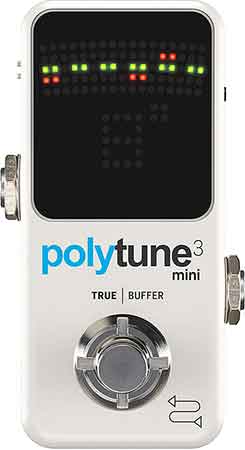
I love TC Electronics. They make such great stuff. The Polytune is a great pedal and is generally found under $100; it’s accurate and fast (unlike a phone app), and you can tune all the strings at once with the polyphonic feature. Literally, strum all the strings and tune as needed. The other positive with this, for those of you that are interested, is that the lights are very easy to read when playing outdoors or under bright lighting. This was an issue that I never thought of until I played a festival in the summer sun and the display on my tuner was completely washed out! That sucked.
Runner-up: Boss Tu-3

This is the industry standard. Everyone and their guitar-playing mother have one. Reliable, fast, incredibly accurate, and durable. Not much more to say. I’ve had 3 of these over the years.
2. Overdrive – Fulltone OCD
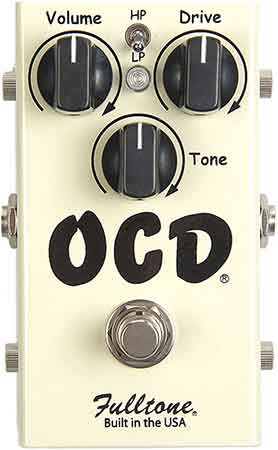
An overdrive pedal gives your electric guitar a nice amount of grit. It’s often recommended to start with overdrive rather than distortion because a distortion pedal is a lot harder to tame and clean up. It’s easier to boost the drive on an overdrive than to reduce the drive on a distortion pedal.
If you have a single-channel amp, then this is a great pedal. Literally every electric guitarist I know has or has had an OCD. They sound wonderful and are solidly built. For those of you who have a dirty channel on your amp, this works very well as a boost pedal when it’s time for a solo. It also gives you a different tonal option if you are not crazy about the overdrive channel on your amp.
If using this pedal on a multichannel amp, use it with the clean channel. I recommend you only use it on an overdriven channel if using it as a signal boost. The signal boost is very important for live performance as you can give your guitar a bump in the mix during an instrumental. This takes this menial task away from the sound engineer who has a lot on his plate already.
Runner-up: Boss Super Overdrive – $70
I like options. If the OCD doesn’t sound like you want it to, then give the Super Overdrive a shot. Boss is probably the biggest name in pedals and for a good reason. This pedal was a staple for Steve Vai for a long time.
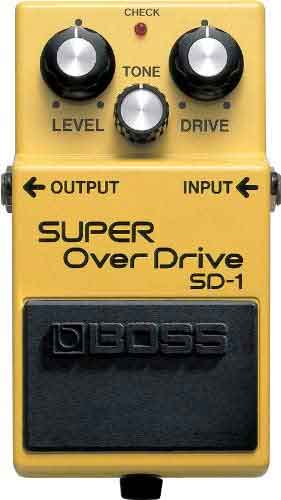
3. Looper – TC Ditto
A good looper is great for two things: practice and solo gigs. One of the most effective ways to practice is playing with tracks, or even better, playing with other musicians. A looper allows you to create your own track by recording yourself and repeating it (looping) for you to play over.

Looping pedals give you the ability to record multiple takes and stack them on top of each other which is a great exercise in creativity. If you want to get out and play coffee houses or small clubs, it’s a great partner to have to give the extra sounds. You are essentially carrying around a band in this small pedal. And it is small, which is one of the reasons I love it.
Runner-up: Boss RC-3 Loop Station
It’s another $100 but it has a lot more features, including built-in drum patterns. It takes a while to figure out and it will take some time to master, but it’s a cool toy for sure.

4. Delay – Boss DD-8
I think I have owned every Boss delay pedal. This one and the DD-3 are the ones to go with. The DD-8 has more bells and whistles and for only like $30 more. The ability to hold the button down to set the tempo of your delay is an important feature for setting the timing. If you find yourself having to set the timing of the delay a lot, then get the external tap tempo add-on for about $40.

Runner-up: Line 6 DL4
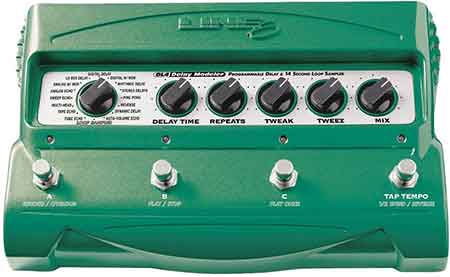
This pedal uses the modeling technology that Line 6 is famous for. It has several delays in a single pedal and it sounds incredible. This opens up a ton of creative possibilities and is a great companion on a pedalboard for live performance. Three delays can be programmed in and the fourth button is the tap to set the tempo. The only downside to Line 6 is they are notoriously secretive with their schematics, so if something goes wrong with the pedal, your repair tech probably can’t fix it.
Both of these delays also have a loop feature which is nice, but the loops are pretty short compared to an actual Looper and they don’t have near the capability. However, it’s good enough if you just need a looper for practicing. In that regard, you really get two pedals in one.
5. Wah-Wah – Dunlop Crybaby
Every electric guitar player needs a Wah-Wah in their signal chain. Whether it’s for 70s funk or 90s metal, the Wah’s unique effect really does wonders for the guitar. Crybaby is the king of the Wah and they have several signature lines, each with its own unique features. When you’re starting out, I suggest going with the original for your first Wah-Wah.
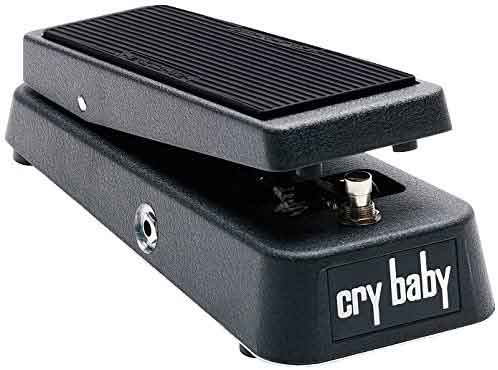
Runner-up: Bad Horsie

I didn’t buy this pedal because I’m a Steve Vai fanboy. In fact, I didn’t buy this pedal. A Morley Bad Horsie 2 was gifted to me by another guitarist after my Crybaby wore out, and I just stuck with the Bad Horsie for several years. The action is different because it feels more like an accelerator pedal. It springs back to the heel position unlike the Crybaby which is free-floating.
It’s also optical, so it doesn’t have a belt on like many other expression pedals have. Other wah pedals turn on and off via a click button under the toe, but this one comes on just by moving the pedal and will turn off when idle. The timer for it to turn off can be adjusted.
I love this pedal for its sound and how convenient it is that I don’t have to click it on and off, but for my next Wah, I may go back to the Crybaby. I just grew to love that sound and I never got tired of it.
Extras:
Power Supplies
You will be tempted not to buy the optional power supply. I recommend resisting this urge. You will spend far more on batteries if you don’t pony up the extra cash for the power supply. I also recommend buying the power supply that is designed for that pedal. Later, when you get multiple pedals, there are multi-tap power supplies you can get to accommodate your pedals, but that will take a little research and it can be expensive.
My Voodoo Lab power supplies were $180 each and as critical as it is for my rig to have two of them, it was a very boring purchase. It sits under my pedalboard, so I don’t even get to look at them! Ah, but the power supply is the unsung hero that holds my whole world together.
Patch Cables
Connecting multiple pedals requires good quality patch cables. The expense can add up quickly, but the reward is great. They help protect against signal loss and degradation as your signal travels from pedal to pedal. When first starting out, no need to get the most expensive ones or the kits that allow you to build your own. Just get the shortest ones you can – the shortest distance allowable to connect your pedals – and make sure you get the ones with gold-plated connectors. They have better conductivity and last longer.
What Should Be Your First Guitar Pedal?
You will not like this. I hated it. I didn’t obey this and you probably won’t, either. Hopefully, you are smarter than me and will heed this advice: GET A TUNER.
If you are to the point where you are buying pedals, chances are you are thinking about playing out with other people. If you are going to play in a band, this is an absolute must. If you are not, it is still my recommendation you get a pedal tuner. Why?
The tuner is your most important tool. If your guitar is not in tune, you will sound terrible forever. If you have a really cheap tuner, it will not be very accurate and you will still sound terrible forever. A good pedal tuner will be a heck of a lot more accurate than a beginner’s handheld tuner or that free app you found in the app store.
The other benefit, especially if you play live, is that it acts as a kill switch so you don’t have to turn off your amp in order to unplug. You can of course tune on the fly as needed between songs, or in the middle of a song in emergencies. You look like an idiot if you have to turn around or go backstage to turn off the amp in order to tune. It’s also incredibly inefficient.
$100 is the standard price of a good tuner pedal. You can usually get a better deal on these pedals on Amazon or used from a music shop. There are cheaper ones but buy at your own risk. It’s not a sexy purchase, but it is so important to be in tune and the ability to kill your signal is an absolute must for live performance.
How Do I Choose?
Prioritizing your goals and what you need to achieve those goals is going to be the way to organize your shopping. What style of music do you play? What sounds do you need most that you can’t get from manipulating your guitar?
If you just can’t seem to find an amp that gives you the distortion you need, then maybe an overdrive or distortion pedal is at the top of your list. Playing live and find yourself as the only guitar player in the band? Consider a good delay pedal. Playing solo shows or need a boost to your practice? Get a looper. The first step is deciding your goals and prioritizing your needs. Which piece of gear gets you to your goal the fastest?
Choosing quality over price should always be your modus operandi. It is better to not have any pedals than to buy cheap, plastic, no-name pedals. They will detract from your sound, not add to it. Spend some money and get a good, trusted pedal. Save some money by going used, but stick to the industry standards when you are first starting out with pedals.
Do You Really Need Guitar Pedals?
Of course not. If you have a low ceiling and don’t mind being a boring, vanilla guitar player and not unlock the full potential of the guitar via modern technology, then no, you don’t need pedals.
In all seriousness, pedals are really nice to have, but they are not needed, strictly speaking. However, if all you have is a guitar and an amp, you are limiting yourself unnecessarily and that is a recipe for abandonment. You’ve invested so much time in learning guitar. Invest a little money and get a pedal or three to take your playing to the next level.
If you have aspirations of playing live, you absolutely need pedals, especially as an electric guitar player. Acoustic players need them, too, just to a lesser extent.
